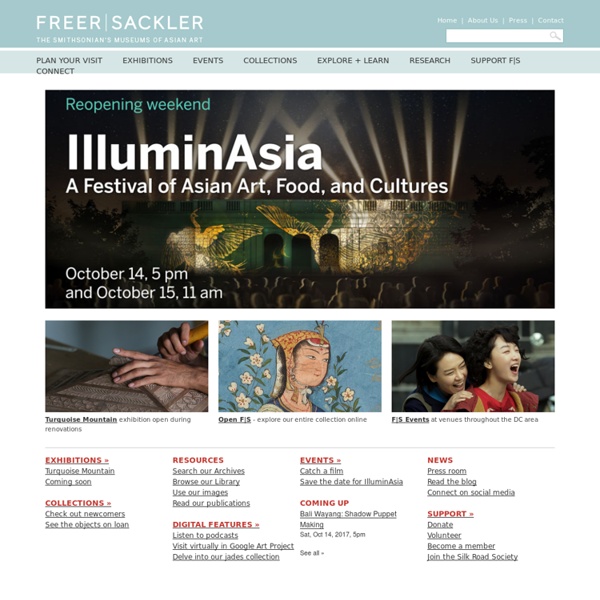



Japanese Monsters - Youkai By Namiko Abe There are a few terms to describe Japanese ghosts. I have introduced "obake" and "yuurei" in my article, "Japanese Ghosts". In this article I will tell you about "youkai," and look at the characters for them. Youkai literally means, "bewitching apparition." Electronic Texts, Primary Sources and Digital Libraries See Also: Archives & Manuscripts | Audio, Video, Multimedia | French Literature | History | Images | Literature | Magazines & Journals Looking for a particular title or author? Best starting place is the Online Books Page, John Mark Ockerbloom's index to full-texts on the Web with links to more than 30,000 books in various formats. ABU: la Bibliothèque Universelle - Over 288 searchable French e-texts, ranging from Balzac to Zola, listed alphabetically by author and title.
Japanese Ghosts By Namiko Abe It's Halloween time! Like many other western customs (Christmas, Valentine's Day etc.), the Japanese easily adopt it, especially for commercial purposes. There are pumpkins displayed at the stores, and some people wear costumes and go to parties. However, there is no real custom for Halloween in Japan. The National Security Archive December 9, 2014 Torture Report Finally Released Senate Intelligence Committee Summary of CIA's Detention and Interrogation Program Concludes CIA Misled Itself, Congress, the President about Lack of Effectiveness. September 28, 2014 THE YELLOW BOOK Secret Salvadoran military document from the civil war era catalogued "enemies," many killed or disappeared. More recent items
Where Did Japanese Come From By Namiko Abe It is not absolutely known to which language group Nihongo (Japanese language) belongs. The structure of Nihongo is completely different from Indo-European languages such as English and French. This is why it is seen as a difficult language to learn from a western perspective. It is known that Nihongo was developed within a reasonably stable (isolated) environment over a long period of time. As a result of this isolation, a form of conversation developed wherein commonly known matters are not spoken of. Radcliffe Institute for Advanced Study at Harvard University The Schlesinger Library holdings date from the founding of the United States to the present and include more than 3,200 manuscript collections, 100,000 volumes of books and periodicals, and films, photos, and audiovisual material. Researchers travel from around the world to use the manuscript collections of Julia Child, the Boston Women's Health Book Collective, Maud Wood Park, and Betty Friedan or to examine comics like Ms. Marvel and periodicals like Bust.
Anthropology of Japan in Japan AJJは日本を人類学的に研究しようとする学者、特に日本在住の研究者に開かれた学会です。毎年秋に定期的な大会を開催し、春にはワークショップをひらいています。また日本文化人類学会の大会と連携した活動をおこなっています。 使用言語は1998年の創設以来、慣習として英語ですが、日本語を含む多言語の使用も認めています。 Black Studies Collection The library’s Black Studies collection has a rich history dating back to student activism and the Civil Rights Movement of the 1960s. In the fall of 1968, African American students at UCSB occupied North Hall and demonstrated against the systematic exclusion of Black Studies from university courses. The university administration accepted demands for the establishment of a Department of Black Studies. In conjunction with this, the Center for Black Studies was created to monitor, coordinate, support, and encourage research in the community. Kenzaburo Oe, "Huckleberry Finn and the American Dream in the Shadow of the Vietnam War", The Asia-Pacific Journal, Vol. 13, Issue. 42, No. 1, October 26, 2015 Translated by Hiroaki Sato Translator’s note: What follows is a translation of the second half of Ōe Kenzaburō’s article, America ryokōsha no yume—jigoku ni yuku Huckleberry Finn, which was first published in the September 1966 issue of the monthly Sekai (The World). The untranslated first half begins, “America. I shall never become entirely free from the oppressing, demonic power of the word America,” and describes how the writer has lived since boyhood “within the conflicting, extremely complicated [inferiority] complex that the word America evokes.” Ōe first read Huckleberry Finn as a boy in a remote Japanese mountain village.
Southern Historical Collection - UNC The Old Well, circa 1892, North Carolina Collection. Replica of Hayes Library in the North Carolina Collection. Students examine items from the Rare Book Collection. SOAS Occasional Translations in Japanese Studies SOAS Occasional Translations in Japanese Studies ISSN: 2049-7571 onlineCopyright © 2012 SOAS, University of London www.soas.ac.uk/jrc/translations/ The SOAS Occasional Translations in Japanese Studies is a multidisciplinary forum for disseminating scholarship on Japan not previously available in English. The series publishes translations of in-depth work from all disciplines as they relate to the study of Japan. All submissions are peer-reviewed by established scholars in the field. The core set of translations for this series derive from an annual workshop convened at SOAS, funded by the Nippon Foundation, with the aim of expanding the base of translated scholarly works on Japan while simultaneously increasing the number of young professionals skilled in translating Japanese language scholarship.
The gallery houses a world-renowned collection of art from China, Japan, Korea, South and Southeast Asia, and the Near East. by nda_librarian Apr 28